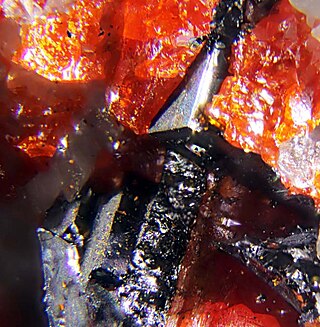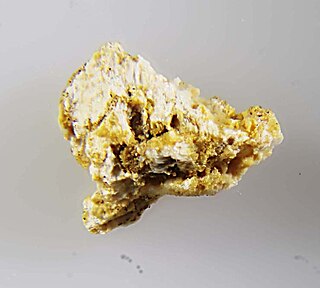Related Research Articles
Florencite-(Sm) is a very rare mineral of the plumbogummite group (alunite supergroup) with simplified formula SmAl3(PO4)2(OH)6. Samarium in florencite-(Sm) is substituted by other rare earth elements, mostly neodymium. It does not form separate crystals, but is found as zones in florencite-(Ce), which is cerium-dominant member of the plumbogummite group. Florencite-(Sm) is also a samarium-analogue of florencite-(La) (lanthanum-dominant) and waylandite (bismuth-dominant), both being aluminium-rich minerals.
Heptasartorite is a very rare mineral with formula Tl7Pb22As55S108. It belongs to sartorite homologous series. It is related to other recently approved minerals of the series: enneasartorite and hendekasartorite. All three minerals come from a quarry in Lengenbach, Switzerland, which is famous of thallium minerals. Chemically similar minerals include edenharterite and hutchinsonite.

Enneasartorite is a very rare mineral with formula Tl6Pb32As70S140. It belongs to sartorite homologous series. It is related to other recently approved minerals of the sartorite series: hendekasartorite and heptasartorite. All come from Lengenbach quarry in Switzerland, which is famous for thallium sulfosalts. Enneasartorite is chemically similar to edenharterite and hutchinsonite.

Hendekasartorite is a very rare thallium sulfosalt mineral with formula Tl2Pb48As82S172. It is one of recently approved new members of sartorite homologous series, by enneasartorite and heptasartorite. All new members come from Lengenbach quarry in Switzerland, prolific in terms of thallium sulfosalt minerals. Hendekasartorite is chemically similar to edenharterite and hutchinsonite.
Ferraioloite is a rare mineral with formula MgMn2+4(Fe2+0.5Al0.5)4Zn4(PO4)8(OH)4(H2O)20. It is related to the phosphate mineral falsterite. Ferraioloite was found in pegmatites of the Foote Lithium Company Mine, Cleveland County, North Carolina, US. The name honors James (Jim) A. Ferraiolo (1947–2014).

Fluorwavellite is a rare phosphate mineral with formula Al3(PO4)2(OH)2F•5H2O. As suggested by its name, it is a fluorine-analogue of wavellite (hence its name), a rather common phosphate mineral. Chemically similar aluminium fluoride phosphate minerals include fluellite, kingite and mitryaevaite.
Kyawthuite is a rare mineral with a simple formula: Bi3+Sb5+O4. It is a natural bismuth antimonate. Kyawthuite is monoclinic, with space group I2/c, and is isostructural with clinocervantite, its trivalent-antimony-analogue. Kyawthuite is also an antimony-analogue of clinobisvanite. Kyawthuite was discovered in the vicinity of Mogok in Myanmar, an area famous for its variety of gemstone minerals. Only one sample of the naturally occurring form of this mineral has been found and is stored at the Natural History Museum of Los Angeles County.

Steinmetzite is a very rare phosphate mineral with formula Zn2Fe(PO4)2(OH)•3H2O. It was discovered among pegmatites of Hagendorf in Germany, that are famous for rare phosphate minerals. Steinmetzite is chemically related to phosphophyllite and other zinc iron phosphates, namely plimerite and zinclipscombite.
Anzaite-(Ce) is a rare-earth element (REE) oxide mineral with the formula Ce4Fe2+Ti6O18(OH)2. An example of chemically related mineral is lucasite-(Ce), although it contains no iron. Cerium in anzaite-(Ce) is mainly substituted by neodymium, lanthanum, calcium and praseodymium. Titanium is substituted by niobium. Trace elements include thorium. The mineral is monoclinic, space group C2/m. Anzaite-(Ce) is hydrothermal mineral found in a carbonatite from the mineralogically prolific Kola Peninsula. The mineral name honors Anatoly N. Zaitsev, who is known for studies of carbonatites and REE.

Cerianite-(Ce) is a relatively rare oxide mineral, belonging to uraninite group with the formula (Ce,Th)O
2. It is one of a few currently known minerals containing essential tetravalent cerium, the other examples being stetindite and dyrnaesite-(La).
Faizievite is a very rare mineral with the formula K2Na(Ca6Na)Ti4Li6Si24O66F2. This triclinic mineral is chemically related to baratovite and katayamalite. Faizievite is a single-locality mineral, coming from the moraine of the Darai-Pioz glacier, Tien Shan Mountains, Tajikistan. Alkaline rocks of this site are famous for containing numerous rare minerals, often enriched in boron, caesium, lithium, titanium, rare earth elements, barium, and others.
Hydroterskite is a rare zirconium silicate mineral, related to terskite (hence its name), with the formula Na2ZrSi6O12(OH)6. It was discovered in the Saint-Amable sill near Montréal, Québec, Canada. It is hydrous, when compared to terskite. Chemically similar minerals include litvinskite and kapustinite.
Itelmenite is a rare sulfate mineral with the formula MnCr2S4. It was discovered in Social Circle meteorite found in Georgia, US.
Manganiceladonite is a rare silicate mineral with the formula KMgMn3+Si4O10(OH)2. It is one of many minerals discovered in the Cerchiara mine, La Spezia, Liguria, Italy.
Maneckiite is a rare phosphate mineral with the formula(Na[])Ca2Fe2+2(Fe3+Mg)Mn2(PO4)6•2H2O. It was found in Michałkowa, Góry Sowie Block, Lower Silesia, Poland.

Wilancookite is a very rare and complex beryllium phosphate with the chemical formula (Ba,K,Na)8(Ba,Li,[ ])6Be24P24O96·32H2O. Wilancookite was discovered in pegmatite of the Lavra Ponte do Piauí complex, Jequitinhonha, Minas Gerais, Brazil.
Wampenite is a rare organic mineral with the formula C18H16, found in Wampen, Fichtelgebirge, Bavaria, Germany.
Monazite-(La) is a relatively rare representative of the monazite group, with lanthanum being the dominant rare earth element in its structure. As such, it is the lanthanum analogue of monazite-(Ce), monazite-(Nd), and monazite-(Sm). It is also the phosphorus analogue of gasparite-(La). The group contains simple rare earth phosphate minerals with the general formula of ATO4, where A = Ce, La, Nd, or Sm (or, rarely, Bi), and B = P or, rarely, As. The A site may also bear Ca and Th.
Monazite-(Nd) is a relatively rare representative of the monazite group, with neodymium being the dominant rare earth element in its structure. This variety of monazite is typically colored bright rose-red. It is the neodymium analogue of monazite-(Ce), monazite-(La), and monazite-(Sm). The group contains simple rare earth phosphate minerals with the general formula of ATO4, where A = Ce, La, Nd, or Sm (or, rarely, Bi), and B = P or, rarely, As. The A site may also bear Ca and Th.
Monazite-(Sm) is an exceedingly rare representative of the monazite group, with samarium being the dominant rare earth element in its structure. It is the samarium analogue of monazite-(Ce), monazite-(La), and monazite-(Nd). It is only the second known mineral with samarium being the mineral-forming element, after florencite-(Sm). The group contains simple rare earth phosphate minerals with the general formula of ATO4, where A = Ce, La, Nd, or Sm (or, rarely, Bi), and B = P or, rarely, As. The A site may also bear Ca and Th.
References
- ↑ Warr, L.N. (2021). "IMA–CNMNC approved mineral symbols". Mineralogical Magazine. 85 (3): 291–320. Bibcode:2021MinM...85..291W. doi: 10.1180/mgm.2021.43 . S2CID 235729616.
- 1 2 Rønsbo, J. G., Balić-Žunić, T., and Petersen, O. V., 2015. Dyrnaesite-(La), IMA 2014-070. CNMNC Newsletter No. 23, February 2015, page 54; Mineralogical Magazine, 79, 51–58.
- 1 2 "Dyrnaesite-(La): Dyrnaesite-(La) mineral information and data". Mindat.org. Retrieved 2016-03-04.
- ↑ "Cerianite-(Ce): Cerianite-(Ce) mineral information and data". Mindat.org. Retrieved 2016-03-08.
- ↑ "Stetindite - Stetindite mineral information and data". Mindat.org. Retrieved 2016-03-08.